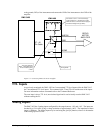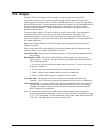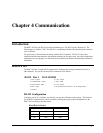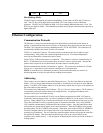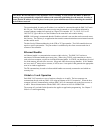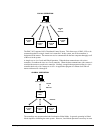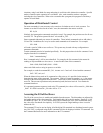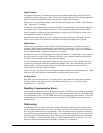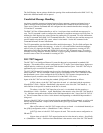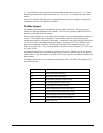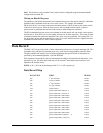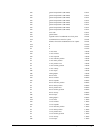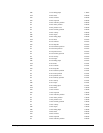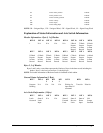
48 • Chapter 4 Communication DMC-3425
Digital Outputs
For outputs, the SB and CB commands are used to command individual output ports, while the OP
command is used for setting bytes of data. The SB and CB commands may be set globally through the
master, while the OP command must be sent to the slave using the SA command.
Outputs may be set globally according to the following numbering scheme: Bitnum = (Slave Handle *
100) + Output Bit. For example:
Set Bit 2 on a UDP distributed slave using the E handle for communication. The E handle would have
a numerical value of 500, plus the bit number of 2. The command would therefore become SB502.
Specific outputs in a distributed system may be read by using the @OUT[n] function, where n is the
corresponding bit number as defined above.
Output bits on an IOC-7007 may also be set through the master controller in a distributed network.
Please refer to the IOC-7007 Manual for information on setting and reading these I/O points.
Digital Inputs
Digital inputs may be addressed individually using the @IN[n] function, or in blocks using the TI
command. Both of these commands may be sent globally to the controller. The ‘n’ in the @IN[n]
function operates identically to the SB/CB syntax. This means that a specific input bit is referenced as
the slave handle number * 100 plus the input bit. For example:
Read input bit 4 on a TCP/IP distributed slave using the C handle for communication. The C handle in
this case would give a value of 300. Therefore, to read bit 4, the command would be MG@IN[304].
The MG in this case simply displays this data to the terminal.
The TI command may be used to read all inputs on a slave in blocks of 8. This is helpful if the slave
controller in question has a DB-14064 expanded I/O daughter card. The TI command uses the slave
handle number * 100 plus the block number to be read. The block number is only used if the
controller has the DB-14064 expansion option.
Inputs on an IOC-7007 may also be read through the master controller in a distributed network. Please
refer to the IOC-7007 Manual for information on setting and reading these points.
Analog Inputs
Each DMC-3425 controller has two 12-bit analog inputs. These inputs are read with the command
@AN[n], where n is the input to be read. The master controller has n = 1 and 2, the first slave
controller uses n = 3 and 4, etc.
Handling Communication Errors
A new automatic subroutine which is identified by the label #TCPERR, has been added. If a controller
has an application program running and the TCP or UDP communication is lost, the #TCPERR routine
will automatically execute. The #TCPERR routine should be ended with a RE command. In the UDP
configuration, the QW commands must be active in order for the #TCPERR routine on the master to
operate properly.
Multicasting
A multicast may only be used in UDP and is similar to a broadcast, (where everyone on the network
gets the information) but specific to a group. In other words, all devices within a specified group will
receive the information that is sent in a multicast. There can be many multicast groups on a network
and are differentiated by their multicast IP address. To communicate with all the devices in a specific
multicast group, the information can be sent to the multicast IP address rather than to each individual
device IP address. All Galil controllers belong to a default multicast address of 239.255.19.56. The
controller's multicast IP address can be changed by using the IA> u command.



